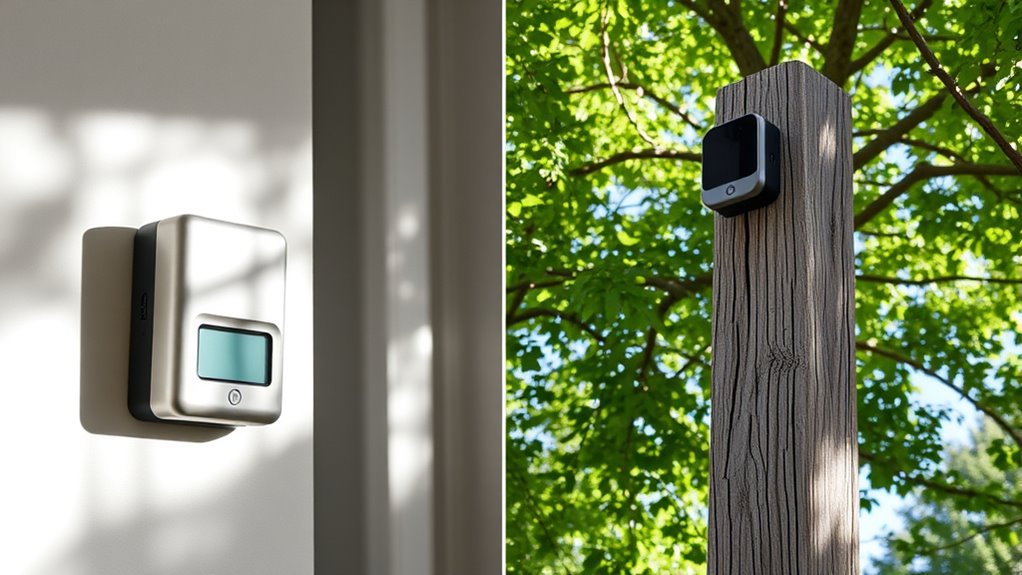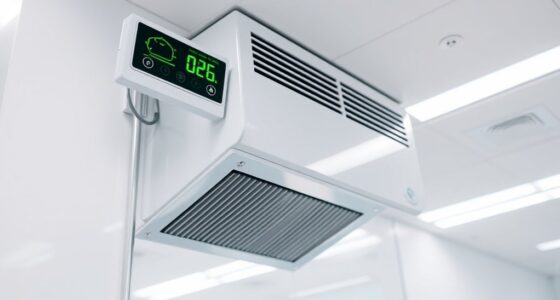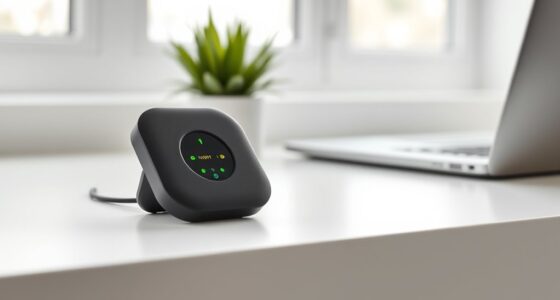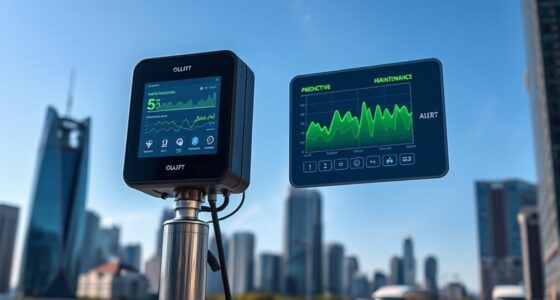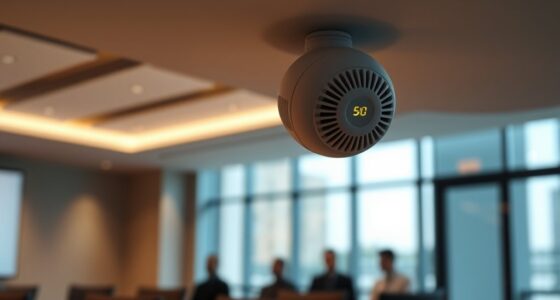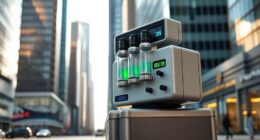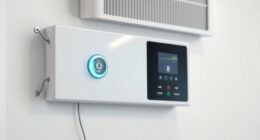Indoor sensors typically need less frequent calibration because they operate in stable environments, making their data more consistent over time. Outdoor sensors, however, face changing weather, dust, and moisture, so they require regular calibration and protective features to maintain accuracy. Environmental factors profoundly impact outdoor sensor performance, while indoor sensors enjoy a more controlled setting. To fully understand how these differences affect your sensor choices, consider the environmental challenges—more details await if you continue exploring.
Key Takeaways
- Indoor sensors experience stable conditions, requiring less frequent calibration compared to outdoor sensors.
- Outdoor sensors face environmental variability, necessitating regular calibration and robust design features.
- Indoor sensors maintain accuracy with minimal adjustments after initial calibration, while outdoor sensors need ongoing calibration.
- Environmental factors like dirt and weather impact outdoor sensor accuracy, demanding protective measures and self-calibration.
- Calibration strategies differ: indoor sensors rely on stable calibration, outdoor sensors incorporate self-calibration and environmental compensation.
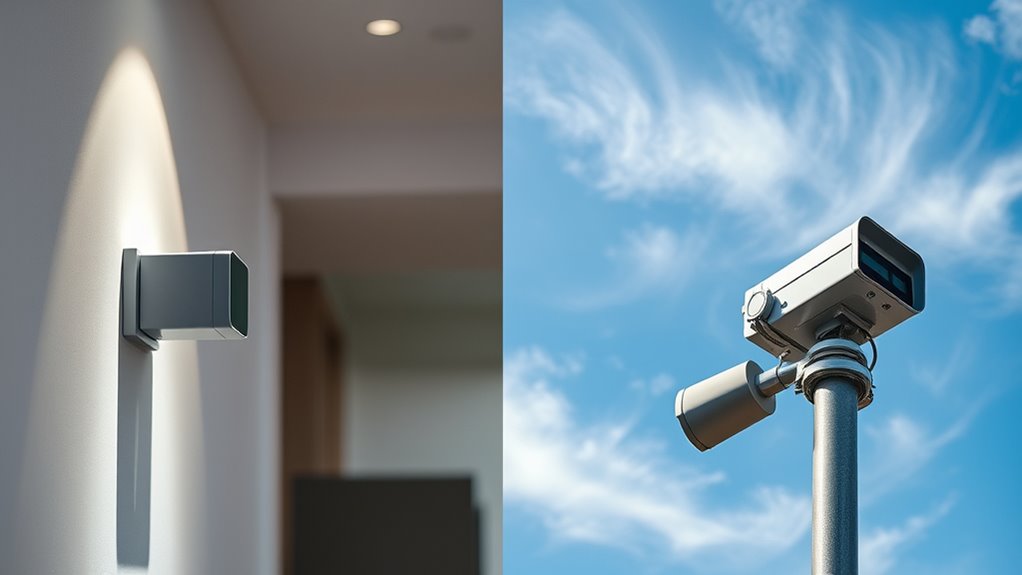
When choosing between indoor and outdoor sensors, understanding their distinct functions and environments is vital. Each type is designed to operate under different conditions, which directly impacts calibration requirements and sensor accuracy. Indoor sensors typically monitor variables like temperature, humidity, or motion within controlled spaces. Because indoor environments tend to be relatively stable, calibration is often straightforward, and sensors maintain their accuracy over time with minimal adjustments. Outdoor sensors, however, face a wide range of environmental variability—such as fluctuating temperatures, wind, precipitation, and sunlight—that can influence their readings. This environmental variability means outdoor sensors need regular calibration and more robust design features to ensure their accuracy remains reliable under changing conditions.
Indoor sensors are simpler to calibrate due to stable environments, while outdoor sensors require frequent adjustments for environmental variability.
When it comes to calibration, indoor sensors generally require less frequent adjustments because the environment they monitor doesn’t change dramatically day to day. For example, a humidity sensor inside a climate-controlled room will experience minimal fluctuations, so once calibrated, it can reliably track changes without constant recalibration. On the other hand, outdoor sensors must be calibrated more carefully and frequently to account for environmental variability. Sudden weather shifts, temperature swings, and exposure to elements can cause drift in sensor accuracy over time. Consequently, outdoor sensors often incorporate self-calibration features or need manual recalibration more often to maintain precision.
You also need to contemplate the impact of environmental variability on sensor accuracy. Indoor sensors, operating in a stable environment, tend to deliver consistent data once calibrated properly. This stability simplifies troubleshooting and reduces maintenance needs. Outdoor sensors, however, are exposed to a dynamic environment, which can introduce noise or inaccuracies if not properly managed. For instance, dust, dirt, or moisture can affect sensor readings, leading to inaccuracies if the sensor isn’t designed to withstand such conditions or if calibration isn’t maintained. To combat this, outdoor sensors usually feature protective housings and advanced calibration algorithms to compensate for environmental changes.
Furthermore, understanding the specific sensor environment is crucial in selecting the right calibration approach for reliable data. Ultimately, your choice depends on understanding these calibration differences and how environmental variability influences sensor accuracy. Indoor sensors benefit from a stable environment, requiring less frequent calibration, and generally provide high accuracy with minimal effort. Outdoor sensors demand more attention, with a focus on durability and ongoing calibration to counteract environmental changes. Recognizing these factors helps you select the right sensors for your needs, ensuring data precision and reliable performance in any setting.
Frequently Asked Questions
How Often Should Indoor Sensors Be Recalibrated?
You should recalibrate your indoor sensors every 6 to 12 months to guarantee peak performance. Regular calibration maintains sensor accuracy, especially considering their lifespan, which can vary based on usage and environment. Keep an eye on any readings that seem off, and recalibrate sooner if needed. Proper calibration frequency helps prevent drift and extends the sensor’s effectiveness, ensuring reliable data for your indoor environment.
What Environmental Factors Impact Outdoor Sensor Accuracy?
Environmental influences like temperature fluctuations, humidity, and exposure to dirt or pollution can markedly impact outdoor sensor accuracy. These factors cause sensor degradation over time, leading to drift or false readings. You should regularly inspect and maintain your sensors to account for these influences, ensuring accurate data collection. Proper calibration and protective measures help minimize environmental impacts, maintaining sensor reliability in changing outdoor conditions.
Are There Different Calibration Standards for Indoor and Outdoor Sensors?
Yes, indoor and outdoor sensors often follow different calibration standards. You should use specific calibration techniques suited for each environment to guarantee sensor longevity and accuracy. Outdoor sensors face harsher conditions, requiring more frequent recalibration, while indoor sensors typically need less maintenance. Proper calibration helps maintain ideal performance, so be sure to adjust settings based on environmental factors. This approach ensures your sensors deliver reliable data over time.
Can Indoor Sensors Be Used Outdoors Safely?
You can’t use indoor sensors outdoors safely, as only 10% of indoor sensors are built for outdoor conditions. Outdoor environments demand sensors with enhanced durability against weather, temperature swings, and humidity. Proper placement strategies are vital to guarantee accurate readings and sensor longevity. If you want reliable outdoor data, invest in sensors specifically designed for outdoor use, which are built tougher and calibrated for harsh conditions.
How Do Sensor Types Influence Calibration Methods?
Sensor types directly influence calibration methods because each type has different sensor precision levels and environmental sensitivities. For example, high-precision sensors require more frequent calibration to maintain accuracy, especially in variable conditions. Outdoor sensors often need more frequent calibration than indoor ones due to exposure to weather and temperature fluctuations. Understanding these factors helps you guarantee your sensors stay accurate, reducing errors and improving data reliability over time.
Conclusion
While indoor sensors keep your home comfortable and safe, outdoor sensors face harsher conditions and more variability. The difference in calibration ensures each sensor type performs effectively in its environment. Think of indoor sensors as precise, delicate tools, while outdoor sensors are rugged explorers. Both are essential, but understanding their calibration differences helps you trust their readings. Ultimately, knowing when and where to rely on each makes all the difference in accurate monitoring.
